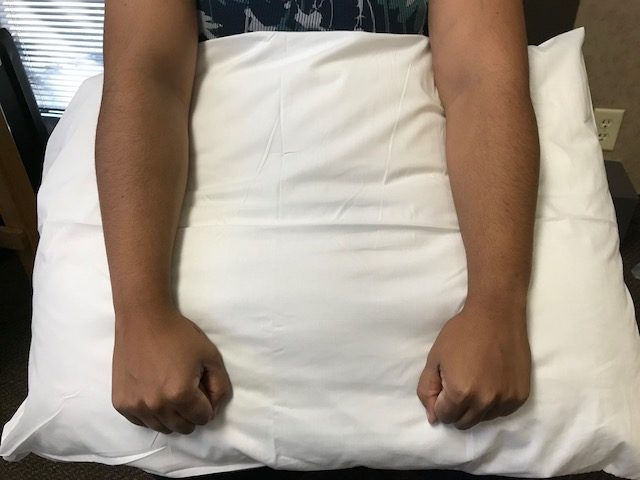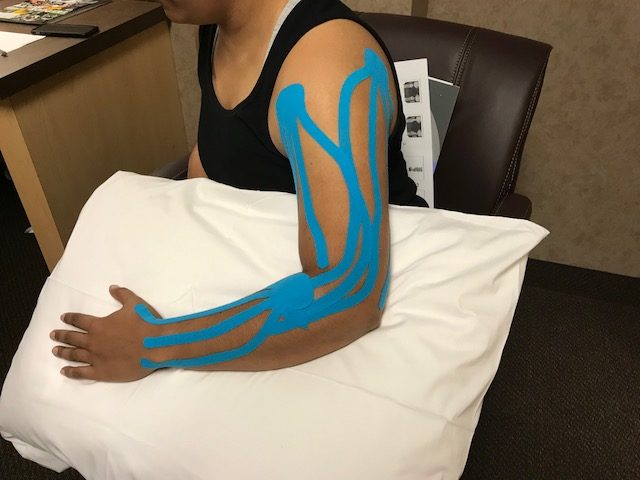The sciences of breast cancer care and breast cancer rehabilitation are changing. Lymphedema, a swelling that can occur after the removal of, or injury to, lymph nodes, is one of the areas which has been slow to change historically. Yet we are learning that if addressed early (with education, detection, and treatment) then the prognosis of breast cancer-related lymphedema may be altered as well.
A Lymphedema Patient
Here’s an example of a lymphedema patient I recently worked with (note: all names and identifying data have been changed to protect patient confidentiality). The patient presented with complaints of left shoulder pain and swelling in her arm after breast surgery and reconstruction complicated by an infection. At her first visit, the volume of her left arm was 100.9% of her right.

Even though it appeared that the the volume of both arms were equal, the patient complained of a feeling of swelling in her left arm. Palpation (physical examination) of the arm revealed slight swelling throughout. In addition, her right arm was dominant and we expected the dominant arm to have been slightly greater in volume than the left, non-dominant, arm.
- At her first visit, we taught the patient how to massage her arm and chest at home to help drain the fluid out of her arm. We also used kinesiotape, a light tape applied to the arm, to help the lymphatic system drain the fluid out of the arm.
- On the patient’s second visit, her left arm volume was 100% of the volume of her right, a slight reduction. More importantly, the patient stated that she felt the arm was less swollen.
- On the patient’s third visit, her left arm volume had decreased by 10%. Her left arm volume was now 90.6% of her right arm.
We obtained a compression sleeve and glove for this patient to assist with continued lymphedema control, which is a part of “CDT” or Complete Decongestive Physiotherapy.

It remains to be seen how she will continue to progress. We are hopeful that by addressing the swelling at an early stage we were able to stop the progression of lymphedema before it becomes irreversible.
In years past, patients were not referred to physical and lymphedema therapies until their swelling was significant. Once a patient was diagnosed with lymphedema, they were told to wear compression forever.
Educating Patients & Providers
However, we are hopeful that more patients will present with early stage lymphedema as did the patient in this example. Lymphedema therapists are trained to identify risk factors, and even though this patient’s risk of lymphedema was only 6% per the literature, the additional fluid load imposed by infection may have triggered early stage lymphedema. Without presentation to lymphedema therapy it is possible that the swelling would have progressed.
Patient education and early intervention has been shown to reduce the risk of lymphedema in a breast cancer patients after an axillary lymph node dissection (LaComba et al. 2010.) Early intervention has been shown to potentially reverse or control early stage lymphedema as described in the case above (Stout et al. 2012).
If you or someone you know has had lymph nodes removed or irradiated, ask for a referral to a lymphedema therapist.
If you are a doctor, nurse, or other healthcare provider, I implore you to think about referring all of your patients who have had lymph nodes removed to a Certified Lymphedema Therapist to teach patients about the early signs and symptoms of lymphedema, and the importance of early intervention.
Knowledge is power, and often, the earlier we can intervene, the better the outcome. After all, cancer rehabilitation is not just about getting rid of the cancer, but also returning the patient to the best quality of life. Proactive, individualized, comprehensive, multidisciplinary care is our best chance to do just that.
- 5 Key Factors That Affect The Healing Process - April 24, 2025
- How Blood Flow Restriction Helps You Do More With Less - April 23, 2025
- 3 Things We Accomplish At Every First Physical Therapy Session - April 15, 2025
